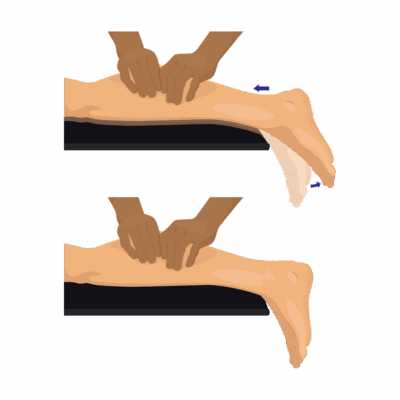Thompson Test
The Thompson Test (also known as the calf squeeze test) is a clinical orthopedic exam used to assess for Achilles tendon rupture (tear). It is considered a highly sensitive and specific test for detecting full or partial discontinuity of the Achilles tendon after trauma or acute plantar flexion injury.
How the Test is Performed
-
Client position: Prone (lying face down) with feet hanging freely off the edge of the table/bed.
-
The therapist firmly squeezes the calf muscle (gastrocnemius/soleus) in the mid-leg.
-
Normal/integrity: The foot should move downward (plantarflex) when the calf is squeezed—as the intact Achilles tendon transmits force from the calf to the heel.
-
Positive test: Absence of plantar flexion, or markedly reduced/weak movement, indicates Achilles tendon rupture (partial or full tear).
-
If plantarflexion occurs, the tendon is likely intact. Partial tears may have subtle, diminished movement.
-
Compare with the unaffected side for clarity.
-
Clinical Significance
-
A positive Thompson Test is a core finding for acute Achilles rupture, confirmed as highly sensitive (up to 96%) and specific (up to 93%).
-
It helps guide urgent referral for surgical/non-surgical management and prevents misdiagnosis when promptly performed after injury.
-
False negatives may occur if the test is done incorrectly, or in cases of partial ruptures, so it should be supplemented with palpation, patient history, and, if needed, imaging.
Assessment
-
Use for clients with acute calf pain/swelling, sudden loss of push-off strength, feeling/hearing a “pop” in the ankle, or after severe trauma/sport injury.
-
Document whether plantar flexion is present or absent, the side affected, and the presence of swelling, deformity, or bruising.
-
Complement with visual inspection and palpation for indentation (“gap”) or swelling above the heel.
Treatment
-
If positive:
-
Do not perform deep tissue work, stretching, or mobilization on the affected tendon—any manual therapy is strictly contraindicated until cleared by a specialist.
-
Educate the client to immobilize the ankle, avoid weight-bearing, and seek urgent medical/orthopedic evaluation.
-
Only begin gentle massage and rehabilitation after adequate healing/stabilization and with specialist clearance.
-
-
If negative but suspicion remains high (e.g., persistent loss of function): Refer for imaging or specialist evaluation.
Safety and Referral
-
Achilles ruptures require prompt specialist care for optimal recovery; delayed treatment increases risk of chronic disability.
-
Post-operative/post-conservative care: Massage therapists may work on surrounding soft tissue for edema, pain, and to support mobility once cleared by the care team.

